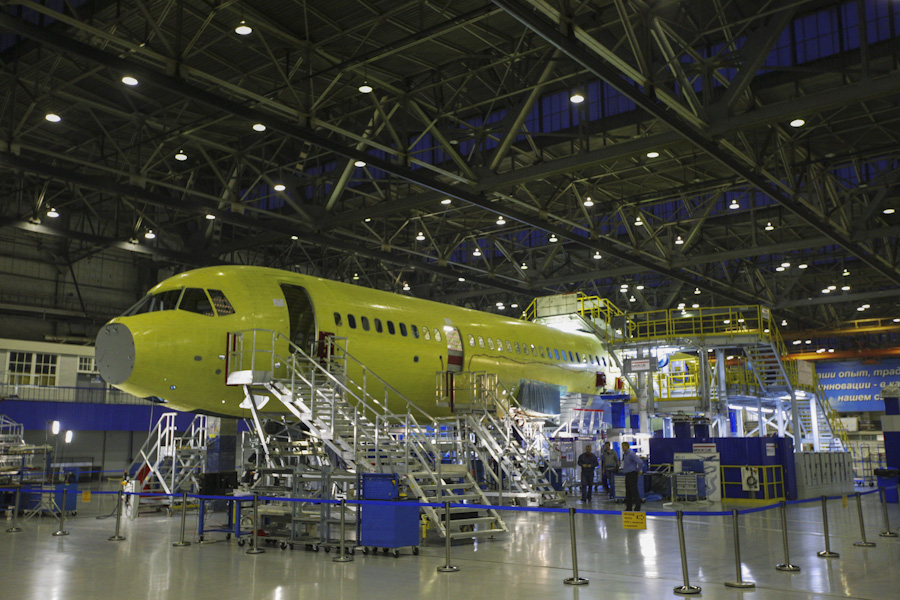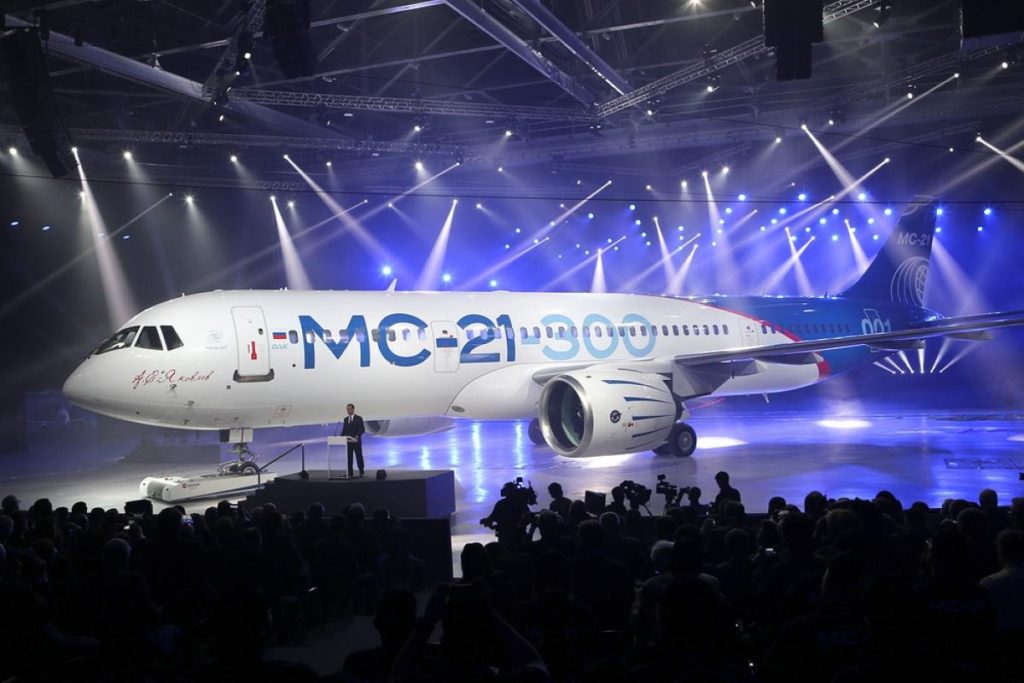Leeham News and Analysis
There's more to real news than a news release.
 Leeham News and Analysis
Leeham News and Analysis
- The Boeing 767 Cross Section, Part 1 November 24, 2022
- Movie Review: Devotion November 21, 2022
- China will accelerate development of its commercial aerospace sector November 21, 2022
- Bjorn’s Corner: Sustainable Air Transport. Part 46. eVTOL comparison with helicopter November 18, 2022
- The economics of a 787-9 and A330-900 at eight or nine abreast November 16, 2022
Airbus, Boeing agree on NMA–for now
One concept of the middle of the market airplane.
Oct. 12, 2016, © Leeham Co.: It’s rare when Airbus and Boeing agree on product strategy, but officials of the two companies seemed in almost perfect alignment in separate interviews by LNC last week.
Barry Eccleston, president of Airbus Americas, and Mike Sinnett, VP of Product Strategy for Boeing, each said there is no consensus yet among customers for the Middle of the Market airplane (MOMA), also known as the New Mid-range Airplane (NMA) at Boeing.
Eccleston was interviewed on the sidelines of the annual Seattle conference organized by the British American Business Council Pacific Northwest. Sinnett was interviewed on the sidelines of the annual Governor’s Conference organized by the Aerospace Futures Alliance, a lobbying group in Washington State.
Posted on October 12, 2016 by Scott Hamilton
Bjorn’s Corner: The Chinese aircraft engine industry
October 07, 2016, ©. Leeham Co: In our Corners on East bloc aeronautical industries, we will now look at the Chinese civil aircraft engine industry.
The Chinese engine industry is closely modeled after the Chinese aircraft industry that we looked at last week. It is organized as divisions and later subsidiaries to the major aircraft companies. Contrary to the Chinese aircraft industry, it has had major problems in gaining the necessary know-how to start developing and producing its own designs.
The industry has built Soviet designs on license since the 1950s and only recently managed to present functional own designs, after many failures.
Posted on October 7, 2016 by Bjorn Fehrm
Airline assets and lessor assets
Subscription required
Introduction
Part 1: The Big Two OEMs
Oct. 3, 2016, © Leeham Co.: There are airline assets and there are leasing assets.
That’s a good airplane but it’s not a good leasing asset.
These are the succinct remarks of just two lessors who decide what aircraft to add to their portfolios.
What do they mean by this and why do they say this?
We’ll take a look today at the thoughts behind these positions.
Summary
- Not all aircraft, however good operationally they may be, make a good acquisition for lessors.
- Lessors have requirements that are beyond those for airlines.
- Lessors play increasing important role in the airline industry.
Posted on October 3, 2016 by Scott Hamilton
Airbus, Airlines, Boeing, Bombardier, CFM, Embraer, GE Aviation, International Aero Engines, Lessors, Pratt & Whitney, Premium, Rolls-Royce
737 MAX 200, 737-7, 737-8, 737-9, 747, 767, 787, 7E7, A319ceo, A319neo, A320ceo, A320NEO, A321LR, A321NEO, A350, A350-1000, A350-2000, A350-800, Airbus, Boeing, Bombardier, CFM, CFM56, Embraer, GE Aviation, GTF, International Aero Engines, Pratt & Whitney, Rolls-Royce, V2500
No sanctions will be levied on Airbus and Boeing in WTO dispute
Subscription Required
Now open to all readers.
Introduction
Sept. 26, 2016, © Leeham Co.: It’s hazardous to use the word “never,” but the US and European Union will never impose trade sanctions or tariffs on Airbus or Boeing airplanes.
No sane president would do so. (Cue Donald Trump.) It would start a devastating trade war and the collateral damage on innocents in the Airbus-Boeing illegal subsidies disputes would be severely harmed.
Summary
- US tariffs on Airbus aircraft and EU tariffs on Boeing aircraft would hurt engine makers, suppliers—innocents in the illegal subsidy disputes.
- Some key customers order from Airbus and Boeing. Tariffs on one or the other company risk alienating these customers.
- Sanctions/tariffs permitted on other companies, industries.
- Canada, Brazil never imposed sanctions in Bombard-Embraer violations.
Posted on September 26, 2016 by Scott Hamilton
44% supplier shortfall for GTF now showing impact
![]() Sept. 6, 2016, © Leeham Co.: It was a stunning admission, one that produced the biggest headlines at the United Technologies media days in June: 44% of the suppliers on Pratt & Whitney’s Geared Turbo Fan engine weren’t performing to the UTC/PW standards.
Sept. 6, 2016, © Leeham Co.: It was a stunning admission, one that produced the biggest headlines at the United Technologies media days in June: 44% of the suppliers on Pratt & Whitney’s Geared Turbo Fan engine weren’t performing to the UTC/PW standards.
The impact of this was seen today when Bombardier announced it will deliver only half the anticipated 15 C Series this year because of engine delivery issues by PW for the GTF powering the new airplane.
Bombardier and PW pointed the finger at its supply chain for the delays in delivering engines.
Posted on September 6, 2016 by Scott Hamilton
Pontifications: “Troubled” 787 is a thing of the past
LNC has been beset by technical issues since Aug. 17 that interferes with e-mail notification as well as links to Twitter, Facebook and Linkedin. We’re working on it with Wordpress.
Aug. 29, 2016, © Leeham Co.: Faulty engines dominated commercial aviation news last week.
First was ANA’s Boeing 787s were hit by issues with its Rolls-Royce engines. Corrosion was found on key engine parts. ANA cancelled flights to inspect and repair the engines.
Unfortunately, some media characterized the matter as the “latest” to hit the “troubled” 787. The London Telegraph is one example.
This characterization, of course, refers to the history of the 787 with its design and production challenges and later by the grounding from the lithium-ion battery fires.
Posted on August 29, 2016 by Scott Hamilton
Russian-Chinese wide-body: background and outlook
By Bjorn Fehrm
Subscription required.
Introduction
August 21, 2016, ©. Leeham Co: The discussions around a joint Russian and Chinese development of a 250-300 seat wide-body has been going on for years.
The project got a more concrete form at President Putin’s visit to China in June. On the 25th of June visit, an inter-governmental agreement to develop and market the aircraft was signed.
At the same time Russia’s United Aircraft Corporation (UAC) and Commercial Aircraft Corporation of China (COMAC) agreed to establish a joint venture for the program.
What market is this aircraft trying to address and will it become a serious player in the wide-body market? Will it give the duopoly Airbus/Boeing something to worry about?
We will address these questions in a series of articles. Before going into the questions around the wide-body program, we will look at the players, UAC and COMAC. Are they up to the job of making a competitive wide-body aircraft?
Summary:
- Russia and China enter the wide-body project with widely different knowledge bases.
- China’s first airliner project, ARJ21, just received local certification after years of delays.
- Russia has produced over 10,000 airliners and has made two generations of wide-body aircraft in the size category.
- The latest wide-body aircraft, Ilyushin IL-96, is on the level of Airbus A340-300 from a technological basis.
Posted on August 22, 2016 by Bjorn Fehrm
Irkut MC-21-300 analysis, Part 3
By Bjorn Fehrm
Subscription required.
Introduction
August04, 2016, ©. Leeham Co: With the classification of the Irkut MC-21-300 done in terms of its size segment (it’s close to the Boeing 737 MAX 9 in size) and the key data of the aircraft analyzed, it’s now time to look at aircraft efficiency and payload-range performance.
We will do this with two cabin configurations for the aircraft. The first will be the nominal two class seating as proposed by the OEMs. For the second, we use a single class layout with 30-inch seat pitch.
Summary:
- The MC-21 has problems to compete with the re-engined 737 MAX 9 in terms of efficiency when using the standard two class cabins.
- When we switch to a single class high density layout, the fuel efficiency improves. The MC-21-300 exit concept is then more similar to the MAX 9, which affects efficiency in a positive way.
Posted on August 4, 2016 by Bjorn Fehrm
Irkut MC-21; we look at the MC-21-300, Part 2.
By Bjorn Fehrm
Subscription required.
Introduction
August 01, 2016, ©. Leeham Co: After having found the nearest competitor to the Irkut MC-21-300 as the Boeing 737 MAX 9 in our first article, we now go deeper in the comparison of the two aircraft.
In the first article, we found that the aircraft have almost identical cabin dimensions. Now we will look at other areas like airframe dimensions, weights and data which dictate overall performance.
Summary:
- The MC-21 has cabin dimensions which are very close to the 737 MAX 9.
- The nominal two class seating by Irkut is lower than the MAX 9. We have assumed that this will increase during the lifetime of the MC-21.
- We also compare other data between the MC-21-300 and the MAX 9, such as weights, wetted areas and effective wingspans to see if these are similar as well. In the end these dictate the aircraft’s efficiency together with the engines.
Posted on August 1, 2016 by Bjorn Fehrm
Airbus, Boeing, CFM, Irkut, Pratt & Whitney, Premium, United Aircraft, United Engine Corp., YAK
737 MAX, A320NEO, A321, Airbus, Boeing, CFM, Irkut, MC-21, Pratt & Whitney, UAC, UEC
Airbus Group 1H2016 results: Trouble in key programs
Updated with analyst reports.
By Bjorn Fehrm
27 July 2016, ©. Leeham Co: Airbus Group presented its first half year results today, posting strong results in the face of delivery troubles with the A320neo and A350; and more charges on the ailing A400M. It has been a troubled start to 2016 with deliveries in key programs (A320, A350, A400M, Super Puma H225) being far behind targets. In total only the space segment is going well in Airbus Group at the moment.
The key commercial aircraft segment is still enjoying a vast backlog (6,700 aircraft) and sales which point to a book to bill of one for the year. But deliveries are not going well. Twenty A320neo “gliders” are just now getting their first engines and the A350 delivery problems are dragging on.
On top of that, the A400M program has hit new problems in the engine area where the propeller gearbox needs a redesign. An interim fix is needed to keep customers flying.
Airbus helicopter side has also hit trouble. The large Super Puma H225 helicopter suffered a fatal off-shore area crash in April and is still grounded as the investigation to what broke in the helicopter is taking time.
The financial results for the Airbus Group for the first half of 2016 (1H 2015) were revenue €28.8b (€28.9b) with net profit €1.8b (€1.5b). These figures includes €1.9b in write offs (A400m €1b, A350 €0.4, Currency €0.5b) and €2.1b in capital gain one offs (Launchers JV valuation €1.1b, Dassault shares €0.9b, Divestitures €0.1b). This means that one time effects kept the result up for 1H 2016 but these will not be there the next quarters should the troubles continue. Airbus Group maintains 2016 guidance for Revenue, EBIT and Free Cash Flow.
Here the details of the Airbus Group divisions results for first half 2016:
Posted on July 27, 2016 by Bjorn Fehrm
Email Subscription
Twitter Updates
My TweetsAssociations
Aviation News-Commercial
Commentaries
Companies-Defense
Resources
YouTube
Archives
- November 2022
- October 2022
- September 2022
- August 2022
- July 2022
- June 2022
- May 2022
- April 2022
- March 2022
- February 2022
- January 2022
- December 2021
- November 2021
- October 2021
- September 2021
- August 2021
- July 2021
- June 2021
- May 2021
- April 2021
- March 2021
- February 2021
- January 2021
- December 2020
- November 2020
- October 2020
- September 2020
- August 2020
- July 2020
- June 2020
- May 2020
- April 2020
- March 2020
- February 2020
- January 2020
- December 2019
- November 2019
- October 2019
- September 2019
- August 2019
- July 2019
- June 2019
- May 2019
- April 2019
- March 2019
- February 2019
- January 2019
- December 2018
- November 2018
- October 2018
- September 2018
- August 2018
- July 2018
- June 2018
- May 2018
- April 2018
- March 2018
- February 2018
- January 2018
- December 2017
- November 2017
- October 2017
- September 2017
- August 2017
- July 2017
- June 2017
- May 2017
- April 2017
- March 2017
- February 2017
- January 2017
- December 2016
- November 2016
- October 2016
- September 2016
- August 2016
- July 2016
- June 2016
- May 2016
- April 2016
- March 2016
- February 2016
- January 2016
- December 2015
- November 2015
- October 2015
- September 2015
- August 2015
- July 2015
- June 2015
- May 2015
- April 2015
- March 2015
- February 2015
- January 2015
- December 2014
- November 2014
- October 2014
- September 2014
- August 2014
- July 2014
- June 2014
- May 2014
- April 2014
- March 2014
- February 2014
- January 2014
- December 2013
- November 2013
- October 2013
- September 2013
- August 2013
- July 2013
- June 2013
- May 2013
- April 2013
- March 2013
- February 2013
- January 2013
- December 2012
- November 2012
- October 2012
- September 2012
- August 2012
- July 2012
- June 2012
- May 2012
- April 2012
- March 2012
- February 2012
- January 2012
- December 2011
- November 2011
- October 2011
- September 2011
- August 2011
- July 2011
- June 2011
- May 2011
- April 2011
- March 2011
- February 2011
- January 2011
- December 2010
- November 2010
- October 2010
- September 2010
- August 2010
- July 2010
- June 2010
- May 2010
- April 2010
- March 2010
- February 2010
- January 2010
- December 2009
- November 2009
- October 2009
- September 2009
- August 2009
- July 2009
- June 2009
- May 2009
- April 2009
- March 2009
- February 2009
- January 2009
- December 2008
- November 2008
- October 2008
- September 2008
- August 2008
- July 2008
- June 2008
- May 2008
- April 2008
- March 2008
- February 2008






